Sasquatch Scholars’ Wallace Problem
Posted by: Loren Coleman on March 30th, 2012
Ray Wallace continues to be the bone of contention in Sasquatch studies. It is time to expunge the cryptid primate track databases of his negative contributions, and look at the real evidence for Bigfoot more clearly.
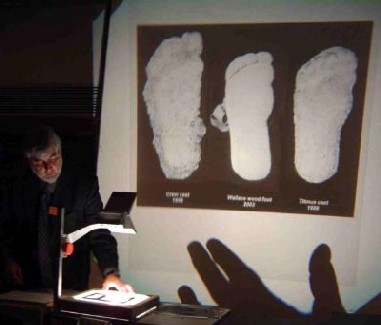
Loren Coleman, London Fortean Times conference talk: Jerry Crew cast, Ray Wallace wooden foot fake, Bob Titmus cast. Fakery afoot?

Ray Wallace make fakes in a wide variety of configurations. Part of the “Toledo Collection” photographed in the 1980s by Ron Schaffner. Used by permission.
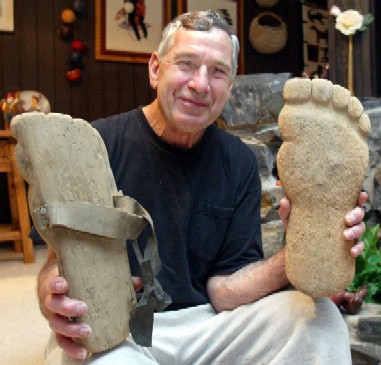
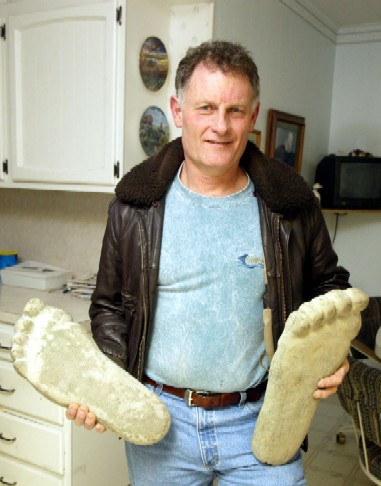
Both photographs © 2002 Dave Rubert. Used with permission.
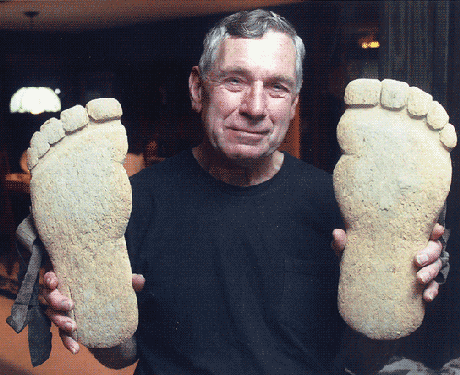
Dale Wallace displays Ray Wallace’s Bigfoot wooden fake feet. (David Rubert Photography – used with permission)
Facts: The Ray Wallace fakes do NOT match the Jerry Crew October 1958 foot cast that began the use of the word “Bigfoot” in a more widespread fashion, nor do they match the Bluff Creek filmsite prints from 1967, one of which is compared below with a Wallace wooden foot.
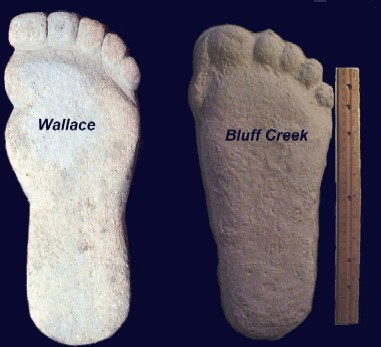
But within various Bigfoot books, you will easily find photos of “Bigfoot” prints (in Sanderson, Slick, and Green collections), which match Wallace’s handiwork. Some are not as easy to identify as others because the placing of footprints is not an exact science and materials do shift around. Nevertheless, some images in some books need to be questioned.
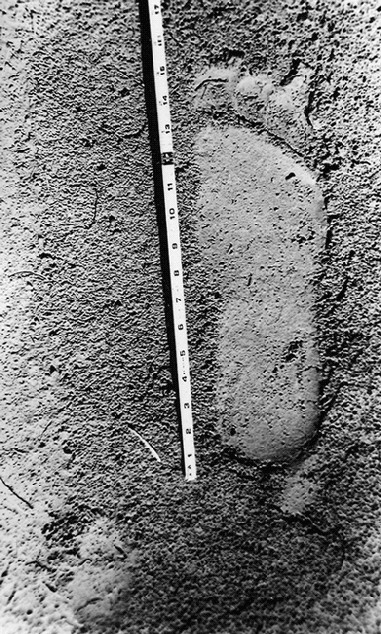
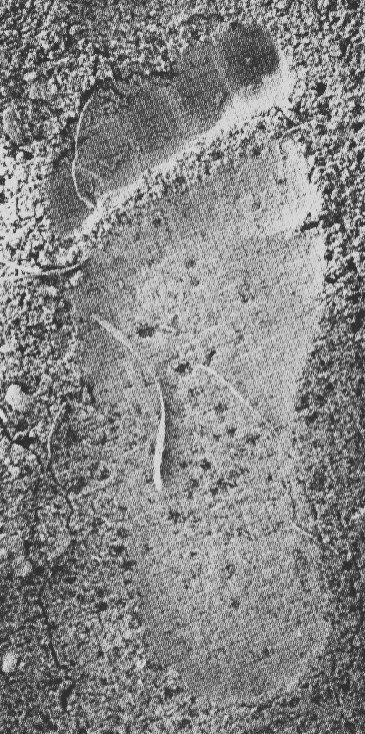
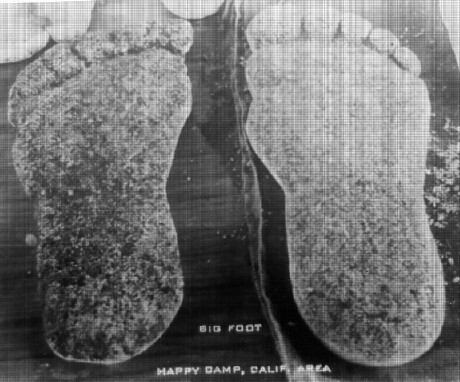
My appreciation is given to Cryptomundo reader Dale Drinnon who has sent in the above scan of an old postcard that was sold at Happy Camp, California, apparently in the 1960s or early 1970s. Drinnon writes: “It looks to me like the one track cast [on the left in the photograph] has [evidence of] that crack in the heel.”
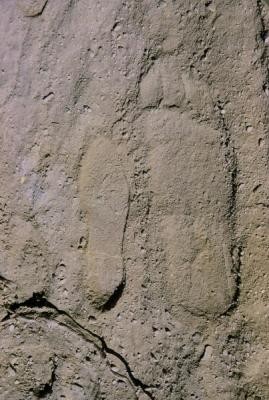
Doreen Hooker’s photographs of the alleged Sasquatch tracks on Blue Creek Mountain – Onion Mountain 1967

René Dahinden photograph, according to Chris Murphy.
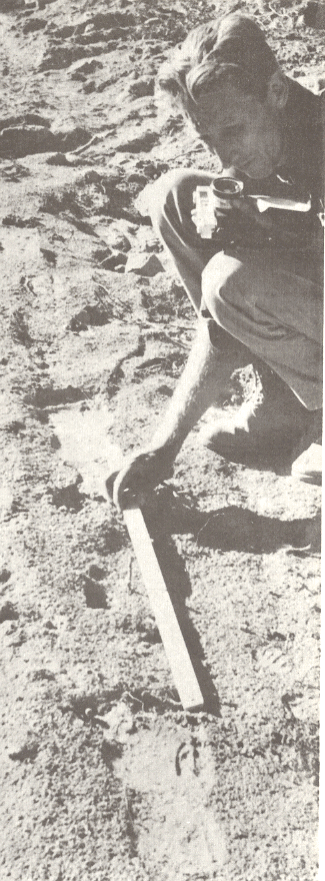
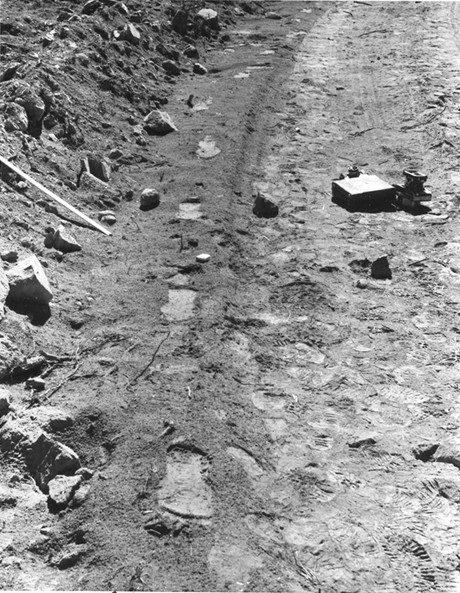
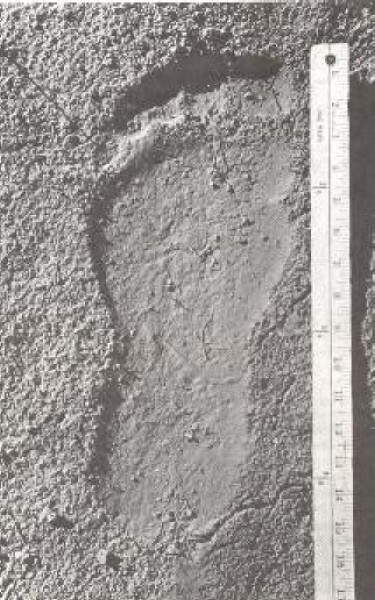
Here are several blog postings from the past that will fill in any reader more completely on the ongoing conflicts between researchers regarding the Ray Wallace data that remains in the databases:
The Ray Wallace Debate – Part II
The Ray Wallace Debate – Part III
The Ray Wallace Debate – Part IV
The Wallace Line in Bigfoot Studies
as noted here in Sasquatch Scholars’ Wallace Problem.
About Loren Coleman
Loren Coleman is one of the world’s leading cryptozoologists, some say “the” leading living cryptozoologist. Certainly, he is acknowledged as the current living American researcher and writer who has most popularized cryptozoology in the late 20th and early 21st centuries.
Starting his fieldwork and investigations in 1960, after traveling and trekking extensively in pursuit of cryptozoological mysteries, Coleman began writing to share his experiences in 1969. An honorary member of Ivan T. Sanderson’s Society for the Investigation of the Unexplained in the 1970s, Coleman has been bestowed with similar honorary memberships of the North Idaho College Cryptozoology Club in 1983, and in subsequent years, that of the British Columbia Scientific Cryptozoology Club, CryptoSafari International, and other international organizations. He was also a Life Member and Benefactor of the International Society of Cryptozoology (now-defunct).
Loren Coleman’s daily blog, as a member of the Cryptomundo Team, served as an ongoing avenue of communication for the ever-growing body of cryptozoo news from 2005 through 2013. He returned as an infrequent contributor beginning Halloween week of 2015.
Coleman is the founder in 2003, and current director of the International Cryptozoology Museum in Portland, Maine.










Now, Loren, that headline was unfairly misleading. When I see the name “Wallace” I automatically think of author Edgar Wallace. And you know HIS creature had the biggest feet of all.
His name was King Kong.
Loren, I’m with you. The obvious AND the suspected fakes need to be culled from the evidence. Though, doing so is likely to be a hard fought battle.
For instance, from photographic evidence (such as you display above), it seems clear that the Onion Mountain tracks are probably (almost certainly) Wallace fakes. Yet there are researchers who claim to have found “dermal ridges” on the plaster casts taken from those prints — artifacts which John Green himself has said were not (as far as he can remember) in the original tracks (nor are they visible in the very clear photos of said tracks).
As Matt Crowley’s research has shown, the act of pouring plaster can itself create “dermal ridge” artifacts in casts of “tracks” made by an absolutely flat surface being pressed into soil. But there are still those who refute that evidence and cling to what they see in the casts. How can we decide? Who is to be the arbiter of what’s real and what’s fake?
Thanks for this posting. The photograph showing John Green measuring stride distance between tracks always looked bad to me. When we see Wallace’s work, there is never any evidence of flexibility or soft tissue variation present. When they are mistakenly presented as valid tracks by researchers, it really damages credibility. If we cannot distinguish between fabrication and presumably genuine prints, what basis is there for meaningful study?
I seem to recall Grover Krantz identifying the double ball observed on Wallace fakes as a hallmark of genuine tracks. Since this feature is seen as a predominant feature of Wallace’s work and almost nowhere else, it indicates to me that even the academics can be fooled.
Seeing hoaxes next to what are believed to be real prints provide an important basis for comparison. No doubt hoaxers have become more sophisticated over time, but if we are looking at the tracks left by a real animal then given a large enough data base to draw conclusions from, we should be able to infer what constitutes a genuine phenomenon from an attempt at deception.
At the risk of seeming like a “firm grasp of the obvious” with this post, I think a bit of common sense would dictate that most fakes would be seen on flat surfaces with fresh dirt, much like the photo were John green is seen measuring. However, these Wallace fakes would simply be easily esposed if you tracked the subject over varying terrains. For example across a stream and up a bank. I have seen track photos which show the creature slipping and the toes curl to gain hold in such instance.
There is no way any of Wallace’s fakes would show this. Also, since they are not flexible you would only get partial tracks when viewing said tracks over irregular terrain. So to me, any tracks on level ground in fressh dirt would be highly suspect, especially if the seem to disappear without explanation.
As a side note, I personally think that bigfoot could be sucessfully tracked but it would take a team of world class trackers and dogs with horses to get the job done. I believe this was the plan with the PG creature which made sense then as it does now. In that case though bad weather and too much time tanspired which ruin a sucessful outcome.
I have espoused this for a while now that I believe BF’s existence could be proven within a year if the following ocurred: a billionaire decided to commit his resources (or an LLC was formed by a group of them) and they hired a team of world class trackers (at least a dozen and have them located across the U.S. and Canada (spread out geographically) and a well publicized “BF siting hot line” was establish both via toll free phone numbers and a live web site, where calls and instant messages would be received around the clock 7 days per week. The call screeners would relay the information to the tracker and his team (which would include some BF experts equivilent to Cliff, Bobo,) who would evaluate whether this would warrant an instant trip to the hot spot location.
Where the big expense would come in would be the transportation of equipment (dogs, horses, etc) at top speed because time would be of the essense. BF reportedly often puts off a horrible stench but I am unaware how long that may last, and with changing weather, time is of utmost importance in getting to the siting area as quicky as possible.
I have had to shoot and kill bigfoot for survival food, and when you skin out the feet you see there is a kind of locking mechanism no other creature has: On the one hand there is a joint along the arch of the foot that allows them to grasp when they want to. But on the other hand when that joint locks into place it is very rigid. So sometimes the tracks don’t show that mid-tarsal break and sometimes they do. It depends on if they have that joint locked. So when they are stitting down to prepare shoots and bulbous roots to eat, they’ll hold it with their feet and peel/clean with their hands. When climbing trees they don’t lock that foot up either, but on long treks they’ll lock in and march like a human.
You can’t fake feet like that. Nobody would have even thought of it.
“I have had to shoot and kill bigfoot for survival food…..”
And you kept no evidence of this? Not one bone,a bit of hide,nothing? I am gonna go out on a limb and say I do not believe you.
@ footerchow:
Oh, boy…
Uh, first, what starving hunter(?) “skins-out the feet”? I’d think a dead Sas would provide a pretty good meal without having to snack on its “little piggies”
Second, you posted on March 31st – a day too early!